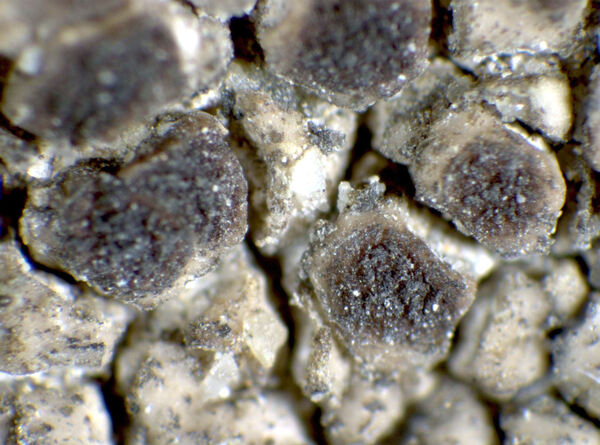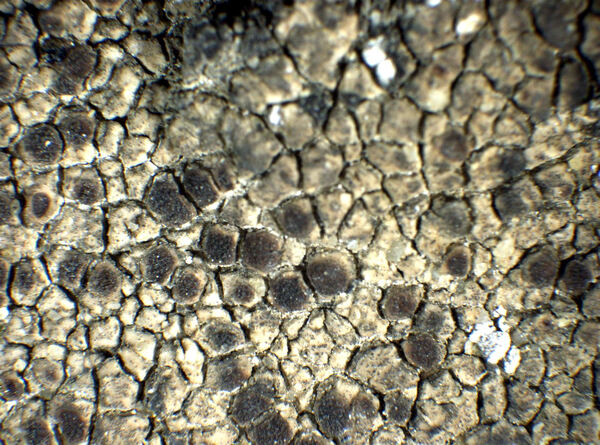Acarospora murorum A. Massal.
Mem. Lichenogr.: 130, 1853.
Synonyms: Acarospora dolophana (Nyl.) H. Magn.; Acarospora macrospora subsp. murorum (A. Massal.) Clauzade & Cl. Roux; Acarospora macrospora var. murorum (A. Massal.) Anzi; Acarospora truncata (A. Massal.) A. Massal.; Biatorella truncata A. Massal.
Distribution: N - VG, Frl. Ven (Lazzarin 2000b), TAA, Lomb, Piem (Isocrono & al. 2003), Emil (Fariselli & al. 2020), Lig (Valcuvia & al. 2000, Watson 2014). C - Tosc, Umb (Genovesi & Ravera 2001, Ravera & al. 2006), Laz (Roccardi 2003), Abr (Nimis & Tretiach 1999), Mol (Ravera & Genovesi 2012, Genovesi & Ravera 2014), S - Si.
Description: Thallus crustose, episubstratic, continuous to areolate, indeterminate, sometimes pruinose, pale brown to sand-coloured when dry, bright green when wet. Areoles 0.7-1.5(-2) mm wide, flat, irregularly rounded or angular, the underside white. Algal layer 40-70 μm thick, irregularly interrupted by perpendicular strands of medullary hyphae; medulla white in upper part, brownish in lower part. Apothecia lecanorine, 0.5-1 mm across, usually 1 per areole, immersed, with a red-brown to dark brown (darker than thallus), concave to flat disc, and a rather prominent thalline margin. Proper exciple colourless, 15-20 μm thick at the base, expanding in upper part; epithecium yellowish brown; hymenium colourless, 100-160 μm high, the hymenial gel euamyoloid, IKI+ persistently dark blue; paraphyses coherent, septate, 2-3 μm thick at base, the apical cells 3-5 μm wide; hypothecium colourless. Asci (30-)40-100-spored, clavate, the apical dome K/I-. Ascospores 1-celled, hyaline, ellipsoid, 6-13 x 3-6 μm. Photobiont chlorococcoid. Spot tests: cortex and medulla K-, C-, KC-, P-, UV-. Chemistry: without lichen substances. Note: a mild-temperate species, most frequent on walls, gravestones, and monuments below the subalpine belt. Related to A. macrospora, but with a different ecology and altitudinal distribution. The correct name may prove to be A. truncata (A. Massal.) A. Massal. (Arcadia 2016).
Growth form: Crustose
Substrata: rocks
Photobiont: green algae other than Trentepohlia
Reproductive strategy: mainly sexual
Commonnes-rarity: (info)
Alpine belt: absent
Subalpine belt: absent
Oromediterranean belt: absent
Montane belt: extremely rare
Submediterranean belt: rare
Padanian area: very rare
Humid submediterranean belt: rare
Humid mediterranean belt: very rare
Dry mediterranean belt: absent

Predictive model
Herbarium samples
Growth form: Crustose
Substrata: rocks
Photobiont: green algae other than Trentepohlia
Reproductive strategy: mainly sexual
Commonnes-rarity: (info)
Alpine belt: absent
Subalpine belt: absent
Oromediterranean belt: absent
Montane belt: extremely rare
Submediterranean belt: rare
Padanian area: very rare
Humid submediterranean belt: rare
Humid mediterranean belt: very rare
Dry mediterranean belt: absent

Predictive model
| Herbarium samples |
 INDEX FUNGORUM
INDEX FUNGORUM
 GBIF
GBIF
 DOLICHENS
DOLICHENS




